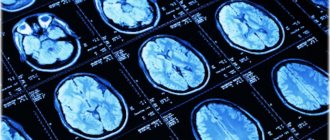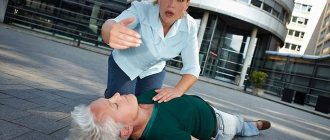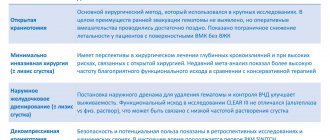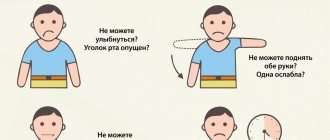Heart attack and stroke are considered the main “killers” of the 21st century. These diseases have a high mortality rate. And if a person survives, he often becomes disabled or has serious complications, which cannot but affect his lifestyle. People who have had a heart attack or stroke have to change their habits. Sometimes this can also apply to driving a car. Can they refuse to replace a driver’s license after a heart attack or stroke, AiF.ru asked lawyer Sergei Kormilitsin . According to him, if these diseases do not lead to serious complications or new diagnoses, then the person has the right to drive a car.
“A heart attack or stroke does not in any way affect the ability to drive a vehicle if it does not result in the development of any diseases from this list - “On the lists of medical contraindications, medical indications and medical restrictions for driving.”
This decree establishes a list of diseases for which you cannot drive vehicles. And in this list there is no mention of a heart attack or stroke, so they have no right to refuse a replacement or issuance of a driver’s license,” the expert said.
Questions and answers When will older drivers fail a medical examination to replace their license?
Features of driving after an impact
Often after a stroke, the most devastating consequences are observed.
They may be as follows:
- mental disorders;
- paralysis of limbs;
- neuropathy;
- aphasia;
- visual impairment;
- lack of coordination of movements;
- disability.
After a stroke, the patient faces a long course of rehabilitation. If he wants to get behind the wheel again, he will have to undergo an examination, based on the results of which doctors will determine his ability to drive a vehicle.
The question of whether it is possible to return to driving a car cannot be given a definite answer. It all depends on the specific clinical case and the severity of the disease.
Reference! It is strictly forbidden to drive if you have epilepsy and numbness of the limbs.
When driving, normal vision is an important factor. Similar problems are recorded in 30% of post-stroke patients. Of course, over time, visual function is restored, but this happens if only a small part of the brain is affected. When its size is impressive, then the loss of this key function is possible.
The patient may be diagnosed with the following problems:
- lack of peripheral vision;
- loss of visual fields;
- optic nerve palsy;
- complete or partial absence of lateral vision.
Thus, only a doctor can determine whether a person will drive and what the consequences of driving are for the patient. Do not neglect the recommendations of your doctor to prevent relapse of this disease.
How is it prohibited to drive a car if you are sick?
The most important thing you need to know is your personal sense of responsibility for the lives of other road users, including many children and pregnant women. We are writing about this because formally, until the next medical examination in order to obtain a certificate for the traffic police, no one may find out that a person has a dangerous disease with which driving is not only prohibited, but also very risky and unwise. And the main problem of interaction between departments in 2021 is that the doctor does not automatically transmit information to the traffic police about the emerging disease.
That is, in fact, if a driver developed, for example, epileptic seizures a year after he first received or changed his license, then he can drive for another 9 years with this dangerous disease. Yes, an inspector can detect a disease randomly and earlier. Or the motorist will be subject to deprivation of his license, which requires a medical examination as a condition for the return of his driver's license.
But legally, only a court can take away your right to drive. In general, there are 3 options when you do not have such a right:
- if you have never received a license,
- if you have been deprived of your rights,
- if the court decided to terminate such a right due to a medical contraindication to driving (Article 28 of the Federal Law on Road Safety).
Why in the latter case can only the court take away such a right, but it does not terminate automatically? Because this is exactly what the Supreme Court pointed out in one of its recent Plenum Resolutions:
A person who does not have the right to drive vehicles is a person who, at the time of committing an administrative offense, did not receive such a right in the manner prescribed by law, a person whose relevant license has expired, as well as a person whose right to drive vehicles was terminated by a court due to with medical contraindications or medical restrictions.
You will also be interested in:
- How to change rights after 10 years through State Services and MFC?
- New law on automatic deprivation of rights due to illness: when will it come into force?
- Is a medical certificate required when replacing a license after loss or damage?
When can you drive?
A post-stroke patient can drive a car after full recovery .
This period is different for each person.
Everything is agreed upon with the attending physician.
The length of the wait depends primarily on the severity of the stroke and the rate of improvement in your general health.
You can drive again only after completing tests on a stimulant and passing a medical commission.
To determine whether a person still has driving skills, it is necessary to pass a specially designed test. It is performed directly in the car in the presence of an instructor or using a computer stimulator. This type of research has disadvantages:
- high price;
- duration of all tasks (about 45 minutes).
Important! Before starting tests, it is necessary to fully restore all lost abilities. Only then will the commission issue permission to return the driver's license.
Testing objectives:
- checking existing knowledge of traffic rules. The instructor, located next to the driver, will determine how adequately he pays attention to the signs and recognizes them. This is how the restoration of visual perception is tested;
- identification of spatial orientation. Here attention will be paid to the correct execution of specific actions and coordination of movements;
- Determining the possibility of making your own route without any help. Here it is important to assess the nature of the post-stroke patient’s thinking, his logic of thoughts and judgments.
A test is a set of specific actions and tasks. Its author is a Belgian scientist who previously studied over 1.5 thousand case histories of post-stroke patients.
People who return to riding after a stroke usually report that the process is difficult and time-consuming. At first it’s almost impossible to get ready, it’s difficult to switch attention. Subjective sensations indicate that the driver has only a third of his previous skills, so he has to learn everything all over again.
First, experts advise driving on less busy roads where there is no active traffic. It is advisable that the speeds be low; you cannot be distracted by conversations. The steering wheel must be held exclusively with both hands.
Return to driving: is it possible?
Unfortunately, such verification is not mandatory. Therefore, the patient often decides independently when he can drive. However, this approach is wrong. The patient himself may inadequately assess his condition and deny obvious problems. It is primarily in his interests to undergo a medical examination. If the decision of the medical commission seems biased, it is wise to seek advice from an independent expert.
How is a person's ability to drive a car assessed?
- mental disorders: delirium, mood swings, neuroses, personality disorders, mental retardation, hallucinations;
- post-stroke epilepsy;
- double-sided blindness;
- double vision as a result of strabismus;
- trembling of the pupil (nystagmus);
- limitation of the field of view by more than 20 0;
- deformation of both hands;
- chronic dizziness.
Blood tests as part of a diagnostic examination for stroke help determine the presence of atherosclerosis and increased blood clotting. These conditions must be combated in order to prevent a repeat catastrophe in the blood vessels of the brain. A general blood test helps to identify inflammatory processes in the body and changes in the number of platelets.
You may be interested in:: Do bailiffs have the right to come to a rented apartment?
Stroke is a dangerous condition that can lead to death and disability. The prognosis directly depends on how quickly the patient was examined by the doctor and treatment was started. Therefore, it is important to be able to recognize the first signs of this condition, and if they occur, you should immediately call a doctor.
What are the first signs and symptoms of a stroke to look out for?
- Every year, approximately 800,000 people have a first or repeat stroke.
- Every 40 seconds, someone in the world experiences this condition.
- Every 4 minutes, one person dies from a stroke.
If, after a stroke, mild motor and speech disturbances persist that do not affect functions important for driving, the issue of admission to driving is decided individually no earlier than a year after a full clinical examination (re-examination - annually).
As explained to AiF in the 24th city polyclinic for special medical examinations in Minsk, after a myocardial infarction, the issue of admission to driving transport is resolved no earlier than 6 months after compensation has been achieved, there are no general contraindications and on the basis of the conclusion of a cardiologist (re-examination – annually).
You may also be interested
After a stroke (cerebral infarction), the issue of admission to driving a vehicle is decided individually in the absence of motor, coordination, speech and other disorders after dynamic medical observation for 6 months and a full clinical examination (re-examination - annually).
First: noise in the head, tinnitus. Second: some flickers and spots before the eyes. Third: numbness of the limbs, numbness of the corner of the mouth, numbness of the tongue. Speech impairment. The slightest memory impairment. These are symptoms that tell you that you need to run to the doctor.
World Stroke Day is celebrated on October 29th . On the eve of this day, FAN talked with a neurologist, Doctor of Medical Sciences Viktor Shakhnovich , who heads the group of innovative neurology of the REC BIOMED Moscow State University. M. V. Lomonosova (Research and Educational Center for Applied Medicine and Food Safety of Moscow State University named after M. V. Lomonosov). Viktor Alexandrovich named the first signs of an impending stroke and gave advice on preventing this dangerous disease.
Cardiovascular disease is getting younger
Why is this happening? Overload, stress, heavy workload, lack of an active lifestyle. But when we talk about an active lifestyle, we think, go to the gym for a couple of hours, and that’s enough, we, they say, are doing the right thing.
- The trial involved 10 patients who had suffered a mild stroke and 10 healthy people with extensive driving experience, all of the same age.
- Testing was carried out on a specially designed simulator - in a city without traffic, using turns, as well as driving on a highway.
- Stroke patients made twice as many errors, especially when turning, crossing intersections, and following distances.
In cases where a stroke is defined as a micro-stroke, a small part of the patient’s brain is affected, the chances of successful treatment and recovery are quite high. Violation of body functions is minimal. After completing a rehabilitation course and the conclusion of a special commission, you can drive a car. But this is allowed only after testing. It is absolutely contraindicated to drive a car or work as a driver after paralysis, in case of muscle spasms or epilepsy.
Consequences of cerebral hemorrhage
Doctors warn the patient about the possible consequences of driving. Stressful situations on the road can trigger another stroke. In addition, scientists have proven that after a hemorrhagic stroke, recovery is more difficult.
People who return to riding after a stroke usually report that the process is difficult and time-consuming. At first it’s almost impossible to get ready, it’s difficult to switch attention. Subjective sensations indicate that the driver has only a third of his previous skills, so he has to learn everything all over again.
The conclusions of the medical commission depend on the general health of the patient, the type of neurological disease and the degree of damage. In any case, it must be remembered that a relapse can occur at any time. Older people are at risk.
You may be interested in :: Low-income family 2021 Izhevsk
Is it allowed to work as a driver?
- difficulty in assessing the situation on the road;
- lack of clarity of thinking;
- difficulties with timely braking;
- complications of actions and poor reactions;
- narrowed visual field.
In order to know whether you can drive a car after a stroke, you need to test your vision and the speed of recognizing road signs, the second test is required to determine your reaction speed, and the third test determines how much the driver is able to follow moving objects on the road.
Problems that the patient may encounter
If the rehabilitation course is successful, the patient may not always be able to drive a car again.
This is hindered by the following problems:
- difficulty in assessing the situation on the road;
- lack of clarity of thinking;
- difficulties with timely braking;
- complications of actions and poor reactions;
- narrowed visual field.
Relevant factors negatively affect human behavior while driving. Such a driver poses a risk to other motorists. He himself may get injured.
Important! Categorical indicators for resumption of driving are cognitive impairment and poor visual abilities.
Statistical information suggests that after a stroke, cognitive impairments make themselves known in 70% of cases. We are talking about deterioration:
- attention;
- memory;
- orientation.
It is these violations that cause concern among specialists, so they cannot issue a permit to drive a vehicle.
How long should you abstain from driving?
The examination is carried out, as a rule, by several doctors - a therapist, a neurologist, a cardiologist, and an ophthalmologist. All previously obtained ultrasound or MRI results are collected, the patient undergoes tests, is interviewed by doctors, and the neurologist conducts standard tests for reaction and memory.
How is a person's ability to drive a car assessed?
I keep calm. And before the stroke, I behaved calmly behind the wheel, and very rarely did anything happen. Now I’m like a concrete pile))) I don’t react to anything. If a certain type is uncomfortable on the road, then it’s time to take a short rest. Let the irritant go ahead))), and I’ll warm up.
Scientists analyzed thirty previous studies examining the ability of people to drive after a stroke. All study participants took the driving test directly on the road. In total, information was collected on 1,700 people, with an average age of 61 years. 54% of them, or 938 participants, were able to successfully complete the tests.
Is it allowed to work as a driver?
A decision on this issue is made by a special commission after a detailed examination and receipt of the results of all tests.
In general, of course, experts recommend changing your profession, because the person behind the wheel is responsible for the lives of passengers.
In addition, recovery from a hemorrhagic type of disease is more difficult.
In fact, you can drive a car in no less than three months. In other countries of the world, the recovery period does not exceed 30 days. It is the doctor who must inform the patient about the dangers of working as a driver after this neurological disease, because it is accompanied by:
- increased blood pressure;
- panic;
- frequent stress.
All these factors are precursors of cerebral hemorrhage. Emergency situations on the roads cannot be ruled out. If, in addition, the driver speaks inarticulately, then conflicts with law enforcement officers may occur.
The conclusions of the medical commission depend on the general health of the patient, the type of neurological disease and the degree of damage. In any case, it must be remembered that a relapse can occur at any time. Older people are at risk.
WELCOME!
GBUZ JSC "AOKB" provides planned, urgent, emergency specialized and consultative and diagnostic medical care to patients in the city of Arkhangelsk and the Arkhangelsk region in the following areas:
| Chief physician Petchin Igor Vasilievich |
cardiology, neurology, gastroenterology, pulmonology, rheumatology, allergology, hematology, nephrology, endocrinology, neurosurgery, surgery (including purulent surgery), urology, traumatology, orthopedics, combustiology (burn medicine), otorhinolaryngology, maxillofacial surgery, vascular surgery , cardiac surgery, thoracic surgery, infectious diseases, obstetrics and gynecology, neonatal pathology, intensive care (including neonatal intensive care).
The institution's 24-hour hospital has 877 beds. Intensive care unit with 40 beds. 10 beds have been deployed in the Solovetsky District Hospital branch. Every year, more than 20 thousand patients are treated in the 24-hour hospital.
Up to 500 patients per shift and more than 100 thousand people annually seek advice from specialist doctors at the clinic. There is a day hospital. The structure of the hospital includes specialized centers for patients, as well as schools and offices in which regular meetings of patients are held with the participation of their relatives, friends and medical specialists.
In total, the institution employs almost 2 thousand medical and general hospital personnel.
For a long time, the State Budgetary Healthcare Institution JSC "AOKB" has been participating in a joint Russian-Norwegian project to reduce road traffic injuries in the Arkhangelsk region.
The hospital operates under the federal program “M8 Highway” as a first-level trauma center. All people injured as a result of road accidents on the Kholmogory highway are taken to the State Budgetary Healthcare Institution JSC "AOKB". This work involves ambulances equipped with the GLONASS system - a system for determining the location of a vehicle involved in an accident.
To help the population of the Arkhangelsk region and the city of Arkhangelsk, an emergency consultative emergency medical care department (ECMC) was created on the basis of the State Budgetary Healthcare Institution JSC "AOKB" in order to improve medical care for adults and, in some cases, children with emergency conditions.
In 2014, a new surgical building was put into operation, which greatly improved the living conditions of patients and the working conditions of doctors in surgical departments.
Read more…
What illnesses can you travel with?
Now let's list the list of diseases that drivers often ask about and which, however, are not on the official list either as contraindications or as special indications or restrictions.
You can definitely drive under the following conditions:
- extrasystole
- ankylosing spondylitis,
- HIV (but depends on its consequences),
- hepatitis,
- brain cyst (if it does not affect mental disorders),
- sleepwalking (if not accompanied by mental disorders),
- migraine and any headaches,
- neuroses in themselves are also not a contraindication, but if they are accompanied by mental disorders, they can become such),
- any hernia (spine, inguinal and others),
- osteochondrosis,
- rheumatoid arthritis,
- Tourette's syndrome (there may be special indications for motor dysfunction),
- Fuchs syndrome,
- tachycardia,
- uterine tone,
- cirrhosis,
- appendicitis,
- cardiac ischemia,
- stroke (if there are no dangerous consequences),
- pneumonia,
- hypotension,
- varicose veins,
- flu,
- gastritis,
- ulcer.
Indications for driving with manual controls
Changing the design of the car by moving one of the pedals higher to allow manual control is mandatory for the following categories of drivers:
- in the absence of a foot or leg completely,
- shortening of one leg by more than 60 mm,
- amputation or stumps of both thighs or legs or only one with a significant loss of motor activity, as decided by a doctor,
- significant motor dysfunction of the legs (for example, due to polyarthritis, kyphoscoliosis, arthrosis and other diseases),
- leg paralysis
What diseases can and cannot travel with?
Let's look at the list of the most common diseases and find out whether they are a contraindication, restriction or special indication for driving in 2021.
Is it possible to manage after a stroke?
Post-stroke condition significantly increases the risk of getting into an accident. However, the disease itself is neither a contraindication nor a limitation to management, since it is not on the list of such. But please note that you should not drive if the following conditions have developed as a result of a stroke:
- dementia of any form,
- amnesia,
- blindness in both eyes.
During pregnancy
Driving while “in a position” is also not a contraindication to driving a vehicle. Moreover, there is no point in finding out until what period you can drive a car, and from how many weeks it is prohibited - any stage of pregnancy formally in 2021 is not a ban on driving.
For epilepsy
But with epileptic disorders, it is prohibited to drive cars of any category, with any medical devices and car design.
The reason for this is simple - epilepsy is officially approved as a contraindication for management and is on the corresponding list, which we will present a little below.
For diabetes
Neither diabetes nor other types of diabetes, regardless of the type of disease, are a condition that limits, let alone prohibits, driving. Diabetics are allowed to drive vehicles of all categories and types.
For encephalopathy
Another disease that, although dangerous, is not regulated in any way by the 2021 legislation to restrict persons with this condition from driving cars.
You can drive with any type of encephalopathy - drug, radiation, traumatic, discirculatory, and so on.
For asthma
Bronchial asthma, despite its sometimes severe symptoms, does not formally prohibit driving machines of any design and category.
For astigmatism
The legislation provides for restrictions on driving vehicles in the presence of refractive error of vision - that is, a decrease in its acuity.
And, since astigmatism is directly related to a decrease in refraction, then on your driver’s license in column 12 they will put o or “Glasses/lenses are required.” It obliges the driver to drive only with vision-correcting devices, and without them there is no right to drive.
We talked about this mark in more detail in a separate article.
For cardiac arrhythmia and other heart diseases
Neither arrhythmia (atrial fibrillation and others) nor other heart diseases are a contraindication to management. They also do not limit the possibility of driving and the category of vehicles.
In addition, nothing prohibits driving with health-supporting devices, for example, a pacemaker.
For Parkinson's disease
Another dangerous condition in its final stages. It is not directly a contraindication to driving a car, regardless of its form and stage. However, if there is dementia (dementia) that has developed as a result, it is already prohibited to control.
For hypertension and hypotension
But high or, conversely, low blood pressure is neither on the list of contraindications nor on the list of restrictions on driving vehicles.
Is it possible to ride with a broken arm or leg in a cast?
Can. If you can do this yourself and, again, correctly assess your capabilities and responsibility to others.
The presence of a cast on a leg or arm is not a contraindication to management. Gypsum also does not require any additional devices for this. There are only restrictions for driving a car only with an automatic transmission or with manual control (instead of the pedals of the handle under the steering wheel) in the absence of a limb or phalanges of fingers. But temporary injuries, of course, do not apply to this.
Can headaches be managed?
Yes. A headache is generally a symptom that can be either the result of an illness or simply a tired, tired state. And the traffic rules directly prohibit driving a car in a tired and painful state. True, there is no punishment for this in 2021, nor will a traffic police officer be able to identify a headache.
With color blindness
And here lies the biggest myth in automobile legislation. In most Internet resources you will find information that color blindness is a complete ban on driving a car. As “proof”, such publications refer to Order No. 302 of the Ministry of Health. But this order regulates periodic medical examinations of workers in hazardous industries, and has nothing to do with the usual examination for a driver’s license.
As of 2021, only one specific type of color blindness is a contraindication to driving - achromatopsia, that is, a complete lack of perception of colors - only a black and white vision of the world. If you have been given this diagnosis on your card (ICD code - H53.51), then you cannot travel. If the condition is different, then it’s possible.
With depression
Depressive disorder refers to affective mood disorders, and those are a condition under which driving a vehicle of any category is completely prohibited.
With sclerosis
Sclerotic disorder is neither a contraindication nor a limitation to management. But a person can forget not only his driver’s license at home, but also the meaning of prohibition signs and other important subtleties of the road.
With oncology
The disease itself has nothing to do with restrictions or complete bans on driving. Unless the cancer causes certain symptoms that jeopardize road safety.
With concussion and TBI
Traumatic brain injuries themselves are different. But if they fit the definition: “34. Traumatic deformations and defects of the skull bones with the presence of severe neurological symptoms” - that is, if they lead to neurological problems, then in this case there is a restriction for the driver. He will not be able to obtain the following categories of rights:
- C – trucks over 3.5 tons,
- CE - trucks with trailers,
- D – buses,
- DE – buses with trailers,
- Tm/Tb – trolleybuses and trams.
But it is quite possible to drive cars and motorcycles with a concussion or other TBI.
With temperature
Remember above we talked about fatigue according to traffic rules? Driving with a body temperature above 37℃ can be attributed to this. And there is no need for anything else - there are no other contraindications or restrictions in the corresponding list for temperature.











